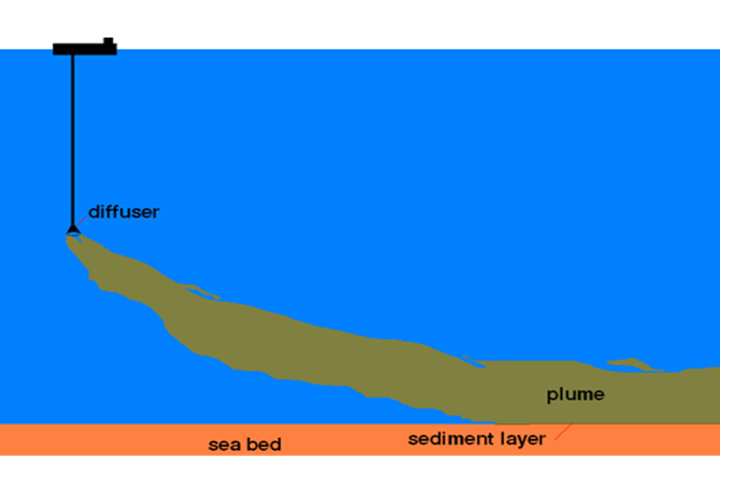Summary
Marine mining is an increasing business encouraged by the global demand of minerals. Though these deep sea mining activities leave literally a footprint on the ocean floor impacting sea life. Chatham Rock Phosphate (CRP) aims to be the premier supplier of direct application phosphate to the New Zealand and global agricultural sector, supporting sustainable farming and agricultural processes. To realize this objective phosphate will be mined at the 400 meter deep Chatham Rise, located in the SW South Pacific Ocean. At a ship the phosphate is separated from the tailings and a plume of tailings will be placed on the ocean floor at a depth of 400 m (see Figure 1). To avoid environmental issues the spreading of the plume has to be controlled. Chatham Rock Phosphate’s failure to get an environmental consent for marine mining in New Zealand is one example of the increasing global need to develop validated tools and methodologies to predict, adaptively manage and reduce the environmental effects of marine mining. Validation of (modelling) tools to predict and manage plume dispersion for deep sea mining (or dredging) operations is hampered by a general lack of field observations on the behavior of mine tailing plumes in deep to very deep water. Validation of hydrodynamics models, underlying sediment models, is feasible by executing long-term (months-year) field observations.
As a feasible alternative approach, this study investigates the behaviour of mine tailings using an innovative combination of state of the art laboratory analyses and modelling to assess both the plume dispersion and the continuous process of settling, deposition and bed formation of mine tailings. The analyses results enable narrowing down of uncertainties in the critical sediment parameters in the predicted behaviour of the mine tailings:
- The settling velocity of the (fine) sediments determining the predicted far-field plume spreading, and;
- The critical shear stress for erosion (determining at what bed shear stress resuspension of sediments will occur in the model) at various distances from the discharge.
Additionally, this project investigates the use of, economically feasible and environmentally acceptable and effective, flocculants as an innovative measure to control (mitigate) the behaviour of the mine tailing plume in deep water, as part of an adaptive management strategy. Mitigation and adaptive management of (deep sea) mining operations is new; as far as we know flocculants have never been used in this type of projects.
Figure 1: Tailings placement
Objective
A final goal is to improve our knowledge and predictive capabilities of both the plume dispersion and the continuous process of settling, deposition, consolidation and associated shear strength development of tailings, and what effect the use of flocculants might have on this.
Methodology
The study comprises 3 phases, each comprising a number of analyses.
Phase 1: laboratory analyses of mine tailing behaviour
- Collation of typical tailing samples for further laboratory analyses
- Accurate determination of sediment settling velocities
- Settling and consolidation columns
Phase 2: laboratory analyses to assess the effect flocculants on tailing behaviour
- Selection of flocculants legal for use in New Zealand
- Determination of optimal flocculants dosage
- Assess operational parameters affecting flocculants performance
- Accurate determination of settling velocities
- Settling and consolidation columns.
Phase 3: modelling
- 1DV modelling (with and without flocculants)
- Reporting; elaboration of results in a set of guidelines.
The majority of the work will be executed in 2017. Pending approval it is aimed for to start the first activity before the end of 2016. Decisions on the details of the implementation of phase 2 and 3 will be based on the results of phase 1.
Expected project results
The main project results are:
- A set of prototype guidelines and lessons learned on:
- Validating the critical sediment parameters required to predict mine tailing (sediment) plume dispersion without a need for trial mining.
- Assessing the feasibility and effectiveness of the use of flocculants as a measure in an adaptive mining strategy.
- Results of how the guideline works for the Chatham Rise project.
Although these guidelines will be developed in the context of the Chatham deep sea mining project, they will be useful in the much broader context of marine mining and dredging for marine infrastructure development. This implies that, besides relevant for the TKI Delta Technology, the envisaged results of this project are also relevant for the TKI ‘Maritiem - Winnen op zee’. In case of positive results, it is likely that the PPS will be continued (see also ‘valorisation’).
Planning
The principle part of the project started January 2017.
The first phase of laboratory analysis of mine tailing behavior is expected to be finished in April. The second phase to asses the effect of flocculants will start during phase 1 and rounded off in June (indication). Lastly the modeling and finalizing the report in planned in June and July.
Progress
The project was suspended by Chatham Rock Phosphate (CRP) in November 2017. At that time, phase 1 was partly finished and steps 1-3 of phase 2 were done. The prototype guidelines were not drafted yet. The results were reported in an internal memo and steps 2 and 3 of Phase 2 are reported in a technical report of Antea Group, to whom this part of the work was subcontracted. In the results section, only part of phase 1 and part of phase 2 is summarized.
The results are reported in the Final report.
